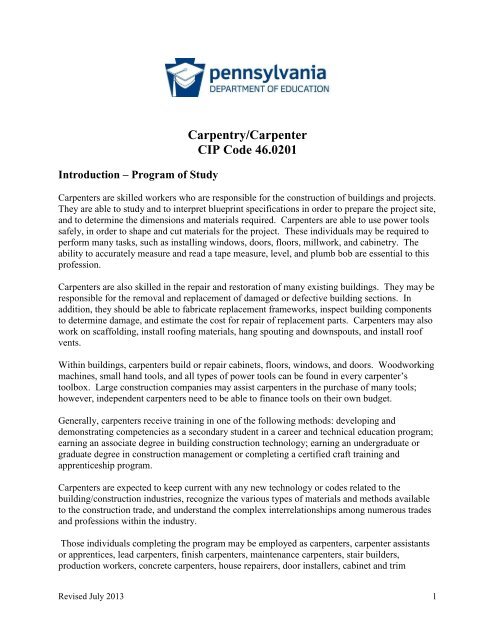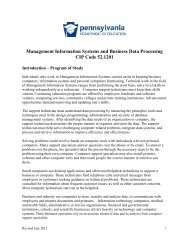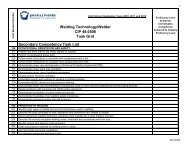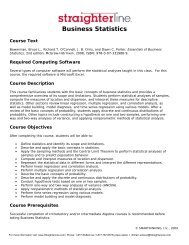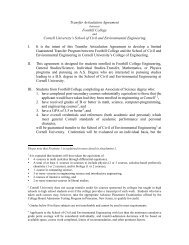Carpentry/Carpenter
Carpentry/Carpenter
Carpentry/Carpenter
You also want an ePaper? Increase the reach of your titles
YUMPU automatically turns print PDFs into web optimized ePapers that Google loves.
Introduction – Program of Study<br />
<strong>Carpentry</strong>/<strong>Carpenter</strong><br />
CIP Code 46.0201<br />
<strong>Carpenter</strong>s are skilled workers who are responsible for the construction of buildings and projects.<br />
They are able to study and to interpret blueprint specifications in order to prepare the project site,<br />
and to determine the dimensions and materials required. <strong>Carpenter</strong>s are able to use power tools<br />
safely, in order to shape and cut materials for the project. These individuals may be required to<br />
perform many tasks, such as installing windows, doors, floors, millwork, and cabinetry. The<br />
ability to accurately measure and read a tape measure, level, and plumb bob are essential to this<br />
profession.<br />
<strong>Carpenter</strong>s are also skilled in the repair and restoration of many existing buildings. They may be<br />
responsible for the removal and replacement of damaged or defective building sections. In<br />
addition, they should be able to fabricate replacement frameworks, inspect building components<br />
to determine damage, and estimate the cost for repair of replacement parts. <strong>Carpenter</strong>s may also<br />
work on scaffolding, install roofing materials, hang spouting and downspouts, and install roof<br />
vents.<br />
Within buildings, carpenters build or repair cabinets, floors, windows, and doors. Woodworking<br />
machines, small hand tools, and all types of power tools can be found in every carpenter’s<br />
toolbox. Large construction companies may assist carpenters in the purchase of many tools;<br />
however, independent carpenters need to be able to finance tools on their own budget.<br />
Generally, carpenters receive training in one of the following methods: developing and<br />
demonstrating competencies as a secondary student in a career and technical education program;<br />
earning an associate degree in building construction technology; earning an undergraduate or<br />
graduate degree in construction management or completing a certified craft training and<br />
apprenticeship program.<br />
<strong>Carpenter</strong>s are expected to keep current with any new technology or codes related to the<br />
building/construction industries, recognize the various types of materials and methods available<br />
to the construction trade, and understand the complex interrelationships among numerous trades<br />
and professions within the industry.<br />
Those individuals completing the program may be employed as carpenters, carpenter assistants<br />
or apprentices, lead carpenters, finish carpenters, maintenance carpenters, stair builders,<br />
production workers, concrete carpenters, house repairers, door installers, cabinet and trim<br />
Revised July 2013 1
installers, framers, assemblers, and woodworkers.<br />
Building a safe, productive and sustainable workforce of carpentry professionals and helping to<br />
address the critical workforce shortage facing the construction industry is vital to the economy.<br />
It is extremely important for an individual to develop a strong carpentry/carpenter framework<br />
that produces portable credentials through a well-designed educational foundation.<br />
Assumptions of this Program of Study<br />
High quality programs should meet the following standards:<br />
1. Promote positive working relationships.<br />
2. Implement a curriculum that fosters all areas of skill development<br />
3. Use appropriate and effective teaching approaches.<br />
4. Provide ongoing assessments of student progress.<br />
5. Employ and support qualified teaching staff.<br />
6. Establish and maintain relationships and use resources of the community.<br />
7. Provide a safe and healthy learning environment.<br />
8. Implement strong program organization and supervision policies that result in high<br />
quality teaching and learning.<br />
9. Integrate academic skills and aptitudes necessary for postsecondary education, gainful<br />
employment and a foundation of lifelong learning.<br />
CIP Code<br />
46.0201 <strong>Carpentry</strong>/<strong>Carpenter</strong><br />
The carpentry program is designed to prepare individuals to apply technical knowledge and skills<br />
to lay out, fabricate, erect, install and repair structures and fixtures using hand and power tools.<br />
This program includes instruction in common systems of framing, construction materials,<br />
measuring, estimating, blueprint reading and finish carpentry techniques.<br />
For more information, contact:<br />
The Pennsylvania Department of Education<br />
Bureau of Career and Technical Education<br />
333 Market Street, 11th Floor<br />
Harrisburg, PA 17126-0333<br />
Phone: 717-346-9735<br />
Fax: 717-783-6672<br />
TTY: 717-783-7445<br />
Revised July 2013 2


